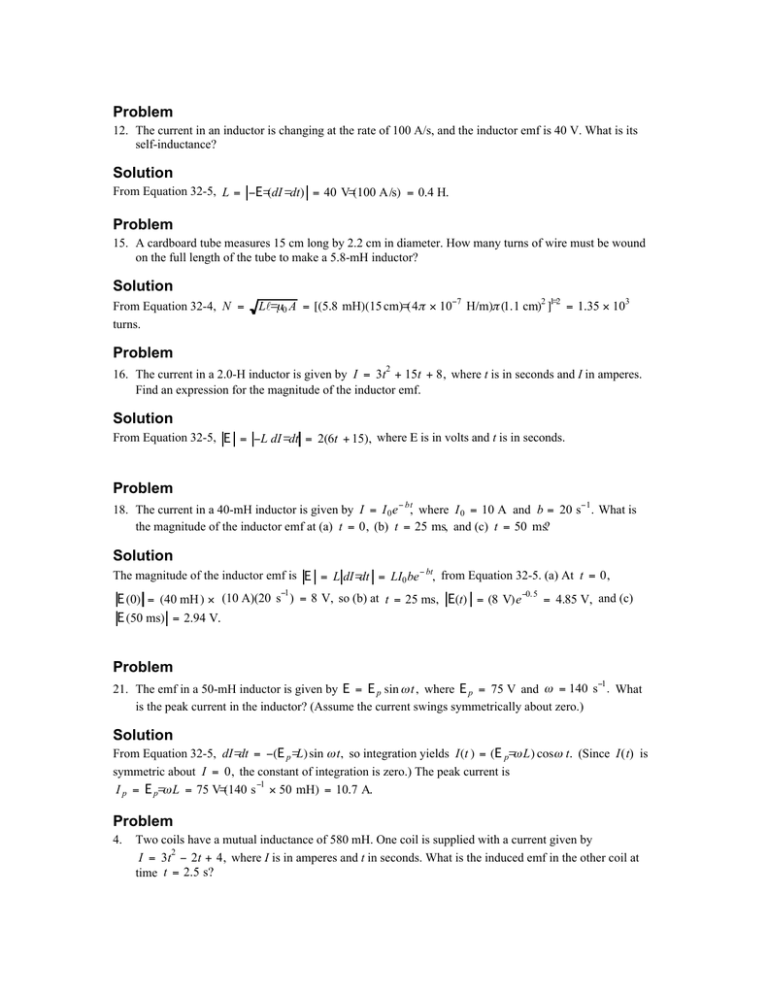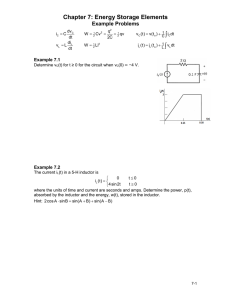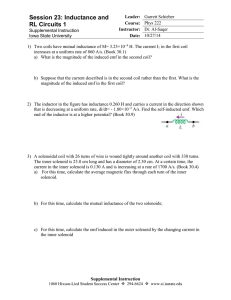Solutions - UCSD Physics
advertisement

Problem 12. The current in an inductor is changing at the rate of 100 A/s, and the inductor emf is 40 V. What is its self-inductance? Solution From Equation 32-5, L = -E=(dI =dt) = 40 V=(100 A/s) = 0.4 H. Problem 15. A cardboard tube measures 15 cm long by 2.2 cm in diameter. How many turns of wire must be wound on the full length of the tube to make a 5.8-mH inductor? Solution From Equation 32-4, N = turns. Ll=m0 A = [(5.8 mH)(15 cm)=(4p ¥ 10-7 H/m)p (1.1 cm)2 ]1=2 = 1.35 ¥ 103 Problem 2 16. The current in a 2.0-H inductor is given by I = 3t + 15t + 8, where t is in seconds and I in amperes. Find an expression for the magnitude of the inductor emf. Solution From Equation 32-5, E = -L dI =dt = 2(6t + 15), where E is in volts and t is in seconds. Problem - bt -1 18. The current in a 40-mH inductor is given by I = I 0 e , where I 0 = 10 A and b = 20 s . What is the magnitude of the inductor emf at (a) t = 0, (b) t = 25 ms, and (c) t = 50 ms? Solution The magnitude of the inductor emf is E = L dI=dt = LI0 be - bt, from Equation 32-5. (a) At t = 0, -1 E (0) = (40 mH ) ¥ (10 A)(20 s ) = 8 V, so (b) at t = 25 ms, E(t) = (8 V)e -0. 5 = 4.85 V, and (c) E (50 ms) = 2.94 V. Problem -1 21. The emf in a 50-mH inductor is given by E = E p sin w t , where E p = 75 V and w = 140 s . What is the peak current in the inductor? (Assume the current swings symmetrically about zero.) Solution From Equation 32-5, dI=dt = -(E p =L) sin w t, so integration yields I(t ) = (E p=w L) cosw t. (Since I(t) is symmetric about I = 0, the constant of integration is zero.) The peak current is I p = E p=w L = 75 V=(140 s -1 ¥ 50 mH) = 10.7 A. Problem 4. Two coils have a mutual inductance of 580 mH. One coil is supplied with a current given by I = 3t2 - 2t + 4, where I is in amperes and t in seconds. What is the induced emf in the other coil at time t = 2.5 s? Solution Since dI1=dt = 6t - 2 (in A/s), Equation 32-2 gives, for t = 2.5 s, E2 = -(580 mH)(6 ¥ 2.5 - 2)( A/s) = -7.54 V (see comment in solution to Problem 1). Problem 8. Coils A and B have mutual inductance 25 mH. At time t = 0 the current in coil A is zero. Subsequently a time-varying current is supplied to A, and the induced emf in coil B is given by E = 50 + 0.2t, with E in V and t in ms. Find an expression for the time-varying current in coil A. Solution Equation 32-2 specifies EB = -M dI A =dt, so dI A=dt = -[50 V + (0.2 V/ms) t]=(25 mH). Integrating, and 2 2 using I A (0) = 0, we find I A (t) = -[(2 A /ms)t + (4 A /(ms) )t ]. The direction of IA depends on how the coils are coupled. Problem 9. A rectangular loop of length l and width w is located a distance a from a long, straight, wire, as shown in Fig. 32-20. What is the mutual inductance of this arrangement? FIGURE 32-20 Problem 9. Solution When current I1 flows to the left in the wire, the flux through the loop is w f B,2 = (m 0 I1=2p ) Ú a+ l dr=r = ( m0 I 1l=2p ) ¥ ln(1 + w=a) (see Example 31-2). Then Equation 32-1 gives a M = f B ,2=I1 = ( m0 l=2p ) ln(1 + w=a). (In calculating the flux, the normal to the loop area was taken into the page, so the positive sense of circulation around the loop is CW. This determines the direction of the induced emf E2 in Equation 32-2.) Problem 10. Two wire loops of radii a and b lie in the same plane and have a common center. Find the mutual inductance of this arrangement, assuming b À a. Hint: With b À a, the magnetic field will be essentially uniform over the smaller loop. See Example 30-1. Solution If b À a is assumed, the magnetic field from the large loop is essentially uniform over the small loop, and equal to the value at the center of the large loop, Bb = m0 I b=2b. Therefore, the flux through the small loop 2 (due to current in the large loop) is f B, a = Bb Aa = ( m0 I b=2b)(p a ), and the mutual inductance is M = f B ,a =I b = m0 pa2=2b. (Note: It would be more difficult to calculate f B, b=I a , from the dipole field of the small loop, but the result for M would be the same.) Problem 28. In a series RL circuit like Fig. 32-8a, E0 = 45 V, R = 3.3 W, and L = 2.1 H. If the current is 9.5 A, how long has the switch been closed? Solution As in the previous problem, t = -(L=R) ln(1 - I=I • ). Here, I • = E0=R = 45 V=3.3 W = 13.6 A, so t = -(2.1 H=3.3 W) ln(1 - 9.5=13.6) = 0.759 s. Problem 30. A series RL circuit like Fig. 32-8a has E0 = 60 V, R = 22 W, and L = 1.5 H. Find the rate of change of the current (a) immediately after the switch is closed and (b) 0.10 s later. Solution From Equations 32-5, and 7, dI=dt = (E0=L)e (b) For t = 0.1 s, dI=dt = (40 A/s)e -Rt=L . (a) For t = 0, dI=dt = E0=L = 60 V=1.5 H = 40 A/s. = 9.23 A/s. -(22 W)(0.1 s)=(1.5 H) Problem 33. Resistor R2 in Fig. 32-22 is to limit the emf that develops when the switch is opened. What should be its value in order that the inductor emf not exceed 100 V? FIGURE 32-22 Problem 33. Solution As explained in Example 32-6, when the switch is opened (after having been closed a long time), the voltage across R2 (which equals the inductor emf ) is V2 = I 2 R2 = E0 R2 =R1. If we choose to limit this to no more than 100 V, then R2 £ (100 V)(180 W)=45 V = 400 W. Problem 36. In Fig. 32-23, take E0 = 12 V, R1 = 4.0 W, R2 = 8.0 W, R3 = 2.0 W, and L = 2.0 H. What is the current I2 (a) immediately after the switch is first closed and (b) a long time after the switch is closed? (c) After a long time the switch is again opened. Now what is I2? FIGURE 32-23 Problem 36. Solution (a) As explained in Example 32-6, the inductor current is zero just after the switch is closed. At this instant, the currents can be determined from the circuit with the inductance open-circuited, so that its branch can be removed. Thus, I 3 = 0, and I1 = I 2 = E=(R1 + R2 ) = 12 V=(4 + 8) W = 1 A. Problem 36 Solution (a) (b) After the currents have been flowing a long time, they reach steady values (dI=dt = 0) , and the voltage across the inductance is zero. The currents can be found by short-circuiting the inductance (see Example 32-6 again, and refer to Chapter 28 if necessary): I1 = E 12 A = = 2.14 A, R1 + R2 R3 =(R2 + R3 ) 4 + 8 ¥ 2=10 I2 = R3 I = R2 + R3 1 1 5 I1 I 3 = I1 R2=(R2 + R3 ) = = 0.429 A, and 4 5 I1 = 1.71 A. Problem 36 Solution (b) (c) When the switch is reopened, no current flows through the battery’s branch, I1 = 0, which can be removed from the circuit to calculate I 2 = I 3 at this instant. The induced emf acts to keep the current flowing at its value in part (b) (as explained in Example 32-6), so I 2 = -I 3 = -1.71 A. Problem 36 Solution (c) Problem 37. In Fig. 32-24, take E0 = 20 V, R1 = 10 W, R2 = 5.0 W, and assume the switch has been open for a long time. (a) What is the inductor current immediately after the switch is closed? (b) What is the inductor current a long time after the switch is closed? (c) If after a long time the switch is again opened, what will be the voltage across R1 immediately afterward? FIGURE 32-24 Problem 37. Solution (a) If the switch has been open a long time, a steady current flows through the inductance (dI L=dt = 0). When the switch is closed (at t = 0 ), IL cannot change instantaneously, so I L (0) = E=R1 = 20 V=10 W = 2 A. (Of course, I1 (0) = I L(0), and I 2 (0) = 0. ) (b) After another long time (t Æ •), the currents are steady again and E L = 0 (the inductance behaves like a short circuit). The 1 resistors are in parallel; therefore I L (•) = E (1=R1 + 1=R2 ) = 20 V 15 + 10 W -1 = 6 A. (c) When the switch ( ) is again opened, the current through R2 is zero, but I L cannot change instantly, so I L = I1 = I L(•) = 6 A. Thus, the voltage across R1 is V1 = I 1R1 = (6 A)(10 W) = 60 V. Problem 38. How much energy is stored in a 5.0-H inductor carrying 35 A? Solution Equation 32-10 gives U = 1 2 LI 2 = 1 2 (5 H)(35 A)2 = 3.06 kJ. Problem 43. The current in a 2.0-H inductor is decreased linearly from 5.0 A to zero over 10 ms. (a) What is the average rate at which energy is being extracted from the inductor during this time? (b) Is the instantaneous rate constant? Solution 2 2 (a) The energy falls from U i = 12 LI = 12 (2 H)(5 A) = 25 J to U f = 0 in Dt = 10 ms, so the rate of decrease is DU=Dt = -25 J=10 ms = -2.5 kW. (b) The discussion in the text leading to Equation 32-10 shows that the instantaneous power is PL = LI (dI =dt), so even if dI=dt is constant, I and PL are not. Problem 46. A 500-turn solenoid is 23 cm long, 1.5 cm in diameter, and carries 65 mA. How much magnetic energy does it contain? Solution Combining Equations 32-4 and 10, we find U = 65 mA) 2 ÷ (23 cm) = 0.510 m J. 1 2 2 2 -7 ( m0 N A=l)I = (2 ¥ 10 H/m)(12 p ¥ 500 ¥ 1.5 cm ¥

